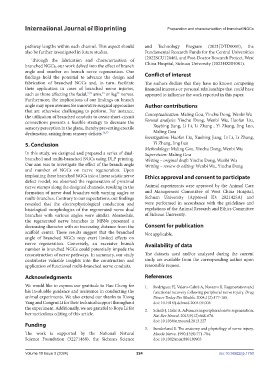Page 232 - IJB-10-3
P. 232
International Journal of Bioprinting Preparation and characterization of branched NGCs
pathway lengths within each channel. This aspect should and Technology Program (2021JDTD0001), the
also be further investigated in future studies. Fundamental Research Funds for the Central Universities
Through the fabrication and characterization of (2022SCU12046), and Post-Doctor Research Project, West
branched NGCs, our work delved into the effect of branch China Hospital, Sichuan University (2023HXBH081).
angle and number on branch nerve regeneration. Our
findings hold the potential to advance the design and Conflict of interest
fabrication of branched NGCs and, in turn, facilitate The authors declare that they have no known competing
their application in cases of branched nerve injuries, financial interests or personal relationships that could have
such as those affecting the facial, arm, or leg nerves. appeared to influence the work reported in this paper.
7,73
74
75
Furthermore, the implications of our findings on branch
angle may open avenues for innovative surgical approaches Author contributions
that are otherwise challenging to perform. For instance,
the utilization of branched conduits to create short-circuit Conceptualization: Maling Gou, Yinchu Dong, Wenbi Wu
connections presents a feasible strategy to decrease the Formal analysis: Yinchu Dong, Wenbi Wu, Haofan Liu,
sensory perception in the glans, thereby preventing erectile Xuebing Jiang, Li Li, Li Zhang , Yi Zhang, Jing Luo,
dysfunction arising from sensory deficits. 76,77 Maling Gou
Investigation: Haofan Liu, Xuebing Jiang, Li Li, Li Zhang,
5. Conclusion Yi Zhang, Jing Luo
Methodology: Maling Gou, Yinchu Dong, Wenbi Wu
In this study, we designed and prepared a series of dual- Supervision: Maling Gou
branched and multi-branched NGCs using DLP printing. Writing – original draft: Yinchu Dong, Wenbi Wu
Our aim was to investigate the effect of the branch angle Writing – review & editing: Wenbi Wu, Yinchu Dong
and number of NGCs on nerve regeneration. Upon
implanting these branched NGCs into a linear sciatic nerve Ethics approval and consent to participate
defect model, we observed the regeneration of proximal
nerve stumps along the designed channels, resulting in the Animal experiments were approved by the Animal Care
formation of nerve dual branches with varying angles or and Management Committee of West China Hospital,
multi-branches. Contrary to our expectations, our findings Sichuan University (Approval ID: 2021425A) and
revealed that the electrophysiological conduction and were performed in accordance with the guidelines and
histological morphologies of the regenerated nerve dual regulations of the Animal Research and Ethics Committee
branches with various angles were similar. Meanwhile, of Sichuan University.
the regenerated nerve branches in MBNs presented a
decreasing diameter with an increasing distance from the Consent for publication
scaffold center. These results suggest that the branched Not applicable.
angle of branched NGCs may exert limited effects on
nerve regeneration. Conversely, an excessive branch Availability of data
number in branched NGCs could potentially impede the
reconstruction of nerve pathways. In summary, our study The datasets used and/or analyzed during the current
contributes valuable insights into the construction and study are available from the corresponding author upon
application of functional multi-branched nerve conduits. reasonable request.
Acknowledgments References
We would like to express our gratitude to Hao Cheng for 1. Rodríguez FJ, Valero-Cabré A, Navarro X. Regeneration and
his invaluable guidance and assistance in conducting the functional recovery following peripheral nerve injury. Drug
animal experiments. We also extend our thanks to Xiong Discov Today Dis Models. 2004;1(2):177-185.
Yang and Congrui Li for their technical support throughout doi: 10.1016/j.ddmod.2004.09.008
the experiment. Additionally, we are grateful to Boya Li for 2. Scheib J, Hoke A. Advances in peripheral nerve regeneration.
her meticulous editing of this article. Nat Rev Neurol. 2013;9(12):668-676.
doi: 10.1038/nrneurol.2013.227
Funding
3. Sunderland S. The anatomy and physiology of nerve injury.
The work is supported by the National Natural Muscle Nerve. 1990;13(9):771-784.
Science Foundation (32271468), the Sichuan Science doi: 10.1002/mus.880130903
Volume 10 Issue 3 (2024) 224 doi: 10.36922/ijb.1750

